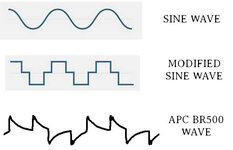Crackle
Newbie
I've been looking at an old APC BR500 Uninterruptible Power Supply which I've never used before.
There is a note in the instructions saying that the output is not Sine Wave, so I wanted to have a look at it.
I connected it up to a digital recorder via a voltage divider circuit and a transformer and am attempting to attach the output to this message.
(The digital recorder method of analysing the wave seems to work, as checking the wave from another inverter gives a lovely sine wave output.)
The output from the APC BR500 has each peak and trough spit into two separate distinct peaks & troughs.
My power meter indicates 230 volts but moving on to the mode where it should display Hz makes it go wrong and need reset.
My laptop charger works fine on it.
Is there something wrong with it or is this how it is supposed to work. (If so, is there a name for the wave produced?)
Any thoughts or comments?
There is a note in the instructions saying that the output is not Sine Wave, so I wanted to have a look at it.
I connected it up to a digital recorder via a voltage divider circuit and a transformer and am attempting to attach the output to this message.
(The digital recorder method of analysing the wave seems to work, as checking the wave from another inverter gives a lovely sine wave output.)
The output from the APC BR500 has each peak and trough spit into two separate distinct peaks & troughs.
My power meter indicates 230 volts but moving on to the mode where it should display Hz makes it go wrong and need reset.
My laptop charger works fine on it.
Is there something wrong with it or is this how it is supposed to work. (If so, is there a name for the wave produced?)
Any thoughts or comments?


